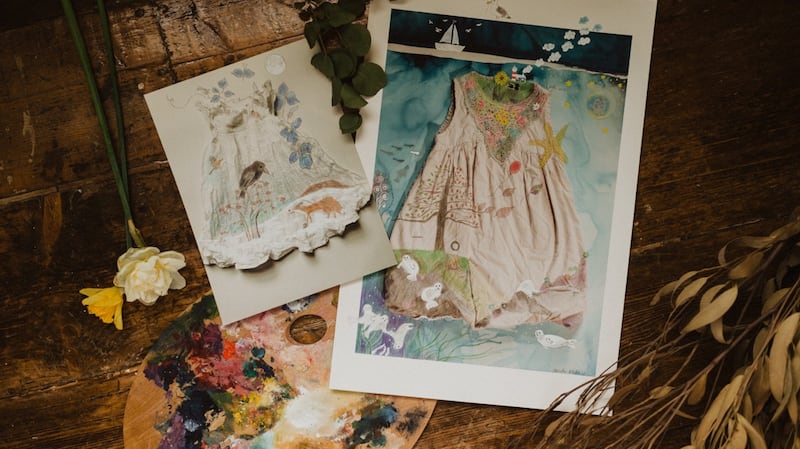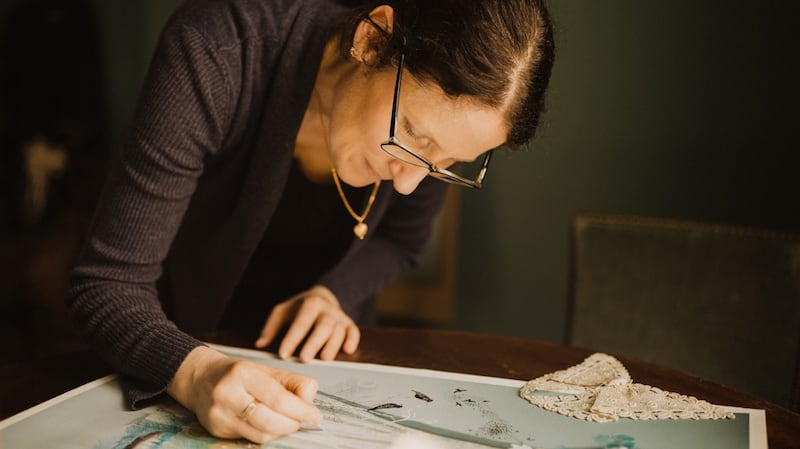A dress is not just an item of clothing, says artist Kerstin Walsh. "It is a vessel that contains a story."
When that piece of clothing has particular significance – a wedding dress, say – “it takes on all sorts of symbolic meanings. It can represent a relationship, a loss, a time in life when [a person was] happiest. What I like to do with my work is preserve those stories, turn their memories into beautiful objects.”
Walsh first began creating her dress portraits after the birth of her daughter in 2011, when the traditional media she used for her art practice became difficult to navigate. “I couldn’t leave my paints open when I was called away, so I was looking for other projects that I could put down and come back to easily. I started taking photographs, still-lifes of white objects mostly, and when my second child was born I started printing them out and colouring them in. I was chatting with a friend about the significance of white objects one day, and she started talking about her wedding dress: how she found it, her marriage, her grandmother. I suggested we take a picture and she would colour it in, but she asked me to do it instead, and when I started colouring I found I was integrating elements of the stories she told me into it.”

When Walsh had finished, she realised how “the shape of a dress, the effect of that white dress on a white background, created a subtle sense of movement and detail”. How, with her embellishments, she had preserved both the dress itself and the life it represented as an artwork.
Since then, Walsh has applied herself to a variety of different vestments, including children’s robes and communion shoes, but mostly wedding dresses.
"I would have a somewhat critical view of the institution of marriage," she explains on the telephone from her home in Cork city, "but what has been interesting for me is to see how a wedding dress expresses so much about a woman's relationship with herself, how it is a vessel for her memories."
Ghost
Despite the near-uniform whiteness, each dress holds the ghost of a unique set of circumstances and experiences.
“I have made a piece based on wedding dresses for happy couples,” she explains. “I have created a piece using two wedding dresses for a same-sex couple. But I have also made a dress portrait for a woman who never got married and wished she could, who had a dress she wanted to wear, but never had the opportunity to.”
I think whether your story ended in a fairytale marriage or not, it can be made into a beautiful artwork
Not all the stories, meanwhile, are narratives of easy joy. “I have seen the whole spectrum of marriages in this project,” Walsh continues, including those that did not work out. “Culturally, we have a very strong idea that marriage is a ‘happy ever after’, and when that doesn’t happen people often very much try to figure out what way they are going. Letting go through their wedding dress can be part of that. The important thing, I think, is that, whether your story ended in a fairytale marriage or not, it can be made into a beautiful artwork.”
The process for each bespoke dress portrait is different, but Walsh gives a general sense of her approach. Central to the process, of course, is “the hearing of the stories”, where Walsh “listens to what is going on for the person and what they are growing from.” (Before becoming a full-time artist Walsh was a social worker, and this has informed her philosophical and practical openness to the individual elements of each story.)
Fluidity and shape
Her first material engagement is the photographing of the dress, which Walsh loves experimenting with, to take advantage of its fluidity and shape. When she captures an image she thinks she can work with, she prints it out on thick matt archival paper, which she values for its luxurious texture. The photograph is then embellished with images and symbols representing the dress’s history, using colour pencil. Walsh has worked on both miniature and large-scale portraits; because she often works on commission, “people usually know exactly where they want to hang it, so that determines the size”.

For her forthcoming project, Walsh will create a piece based on her own wedding dress: a traditional sari, which was given to her by her Indian in-laws when she got married there. “It is a big project,” she says, “epic, like an Indian wedding, which goes on for five days. And a wedding sari is very different in some ways to what a wedding dress represents.” Firstly, “the sari is not chosen by the bride, and there are actually a number of different saris for different times during the celebrations. There are rules about who buys your sari depending on their relevance in the family, so there is deep symbolism there.”
Walsh’s material process will also be adapted to reflect the intercultural marriage: working with a Cork-based Pakistani artist, she will use a traditional Indian painting style and hand-mixed paint made with natural pigment for the canvas. After all, she concludes, “those details are now part of my story.”













